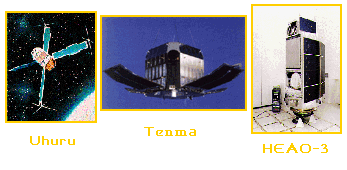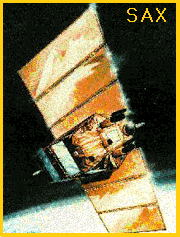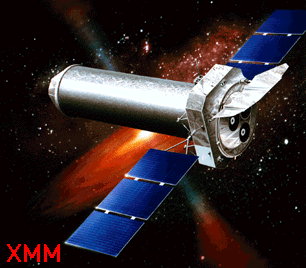|
|

|
High-Energy Astrophysics Satellites |
We give here highlights of the history of the satellites which have been
used in high-energy astrophysics.
Highlights of High-Energy Satellites
A 1949 sounding rocket experiment showed that the Sun emitted X-rays
(Friedman et al 1951) and another sounding rocket experiment in 1961 showed
that other celestial sources emitted X-rays. Observations of celestial X-ray
sources must be carried out above most of the Earth's atmosphere, which
absorbs this part of the
electromagnetic
spectrum. The numbers, sizes, and sophistication of X-ray detection
systems have increased rapidly since their simple beginnings in the 1960s.
The Past

The first dedicated gamma-ray
astronomy
mission was, in fact, the first high-energy
astrophysics
satellite as well.
Explorer-11 was launched
in 1961. The instrument package weighed 30 pounds, was 20 inches high and 10
inches in diameter. They believed that they detected 22 cosmic gamma-rays.
The first orbiting mission which was dedicated to celestial X-ray astronomy
was Uhuru, launched in 1970.
(Other important satellites preceded it, such as
OSO-3 and
Vela 5B, but these
were not dedicated astrophysics missions). Uhuru had a simple complement of
instrumentation covering the energy range 2-20 keV. It provided the first
comprehensive view of the entire X-ray sky. The final catalog of detected
point sources contained 339 objects, which were primarily
binary stellar
systems,
supernova
remnants,
Seyfert
galaxies and
clusters
of galaxies.
Many important missions followed Uhuru in the 1970s, including
ANS,
Copernicus,
SAS-3,
Ariel V, and
OSO 8. These missions
discovered X-ray bursts, numerous pulsars, and obtained the first detailed
X-ray spectra. Another great leap forward occurred in 1977 with the launch of
NASA's first High Energy
Astrophysical Observatory (HEAO-1). HEAO-1 carried 4 major instruments,
covering the energy band 0.2 keV to 10 MeV. It generated a catalog of
approximately 850 point sources during its 18 month lifetime, allowed the
first comprehensive measurement of the diffuse X-ray background, and performed
time variability studies on millisecond time scales. The
Einstein Observatory (HEAO-2)
was launched in 1978, carrying the first fully imaging X-ray telescope.
Following this was EXOSAT,
Ginga, and many other highly
successful missions.

The Present
There are currently eight on-going missions dedicated to celestial X-ray
and gamma-ray astronomy: the Kvant module attached to
the space station Mir,
Granat, the
Array of Low Energy X-ray Imaging Sensors (ALEXIS),
Compton
Gamma-Ray Observatory (CGRO),
Advanced Satellite for Cosmology and
Astrophysics (ASCA), the Rossi X-ray Timing
Explorer (RXTE), the Italian
Satellite
for X-ray Astronomy (SAX), and the Chandra
X-ray Observatory (CXO). These are supplemented by a host of other
missions, which have other primary goals, but which contain instruments
sensitive to high-energy cosmic radiation (such as
Ulysses,
Wind, and the
Defense Meteorological Satellite
Program (DMSP) series). Both individually and collectively, these
satellites have provided an unprecedented view of the high-energy universe.
ROSAT has produced a catalog containing over 62,000 point sources; ASCA has
measured the energy
spectrum of
objects with unprecedented
resolution; CGRO has monitored the mysterious gamma-ray burst phenomena
over five years with unrivaled source location and timing information.
The Future
The next ten years is filled with the expected launches of high-energy
missions which will observe the universe with increased timing resolution,
spectral
resolution, broad-band energy ranges, and multi-wavelength coverages.
These missions include
Spectrum-X-Gamma (http://hea-www.harvard.edu/SXG/sxg.shtml),
Astro-E,
and the X-ray
Multiple Mirror (XMM) satellite. The
missions also represent the movement toward multi-national missions that has
become more and more important in recent years. Collaborations between the
United States, Russia, Japan, the European Space Agency, as well as Space
Agencies from Italy, Argentina, and other nations are all involved in these
exciting new missions.

 Takeme to an alphabetical listing of High-Energy Missions (http://heasarc.gsfc.nasa.gov/docs/heasarc/missions/alphabet.html).
Takeme to an alphabetical listing of High-Energy Missions (http://heasarc.gsfc.nasa.gov/docs/heasarc/missions/alphabet.html).
 Take me to a more detailed summary, including a mission timeline and missions by energy range (http://heasarc.gsfc.nasa.gov/docs/corp/observatories.html). Take me to a more detailed summary, including a mission timeline and missions by energy range (http://heasarc.gsfc.nasa.gov/docs/corp/observatories.html).
|
